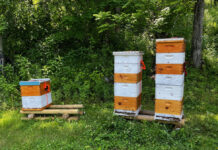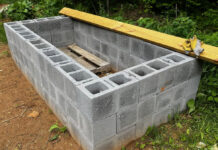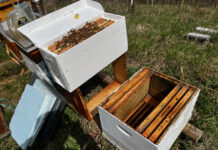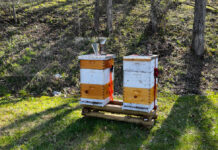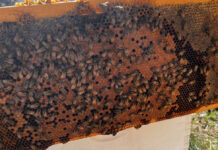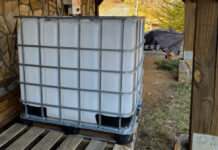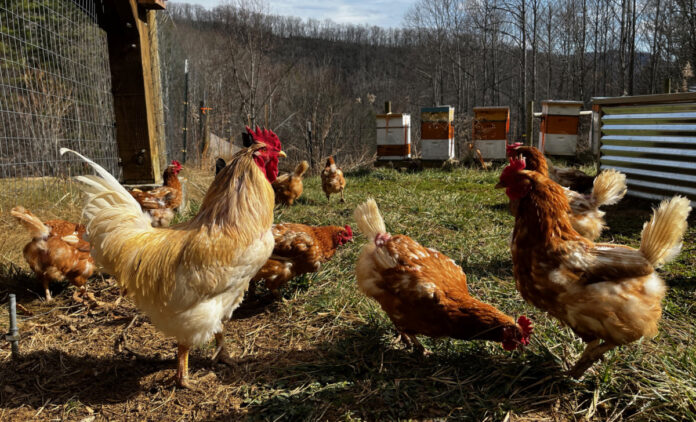
During the recent week of warmer weather, the amount of eggs the chickens produced gradually increased until we got 15 in one day, a far cry from the low of one we experienced during the bitter cold weather. I found this reassuring because it implies the chickens will regain their robust rate of production once spring is here to stay.
The rooster appears to have suffered some frostbite on his comb. I had read about this, but never seen it in prior years. None of the hens’ combs were affected, but his was because it is so much larger. The rooster also is twice as large as the hens, so I expect his head sticks out when they huddle together on their roosts to keep warm in the coop.
The frost bitten portion turned black and is looking flimsier every day. I expect it will fall off soon. In the meantime, he’s carrying on. It hasn’t slowed him down in the fertilization department. When I was cleaning out the coop, I saw him jump at least three hens.
The bees have also suffered from the cold. Two of my hives appear to have died. That’s twice as many hives as I have lost in prior winters, and the season isn’t over yet. Whether they froze or starved, I won’t know until I open the hives. I fed the remaining hives, hoping to give them a boost. The bees also visited the feeder filled with powdered pollen substitute. I’ve had it for two seasons, and this is the first time I have witnessed bees using it.
Perhaps I cursed myself when I said I wasn’t planning to expand my apiary any further.
More Bad News
We got some wet weather last week, and before it turned to snow, it eroded more of the hillside that had been swept clean by the landslide. With no plants to stop the stream of water, it takes the path of least resistance and brings some dirt down with it. The rocks at the bottom acted as a channel, and we had small island of mud forming in the very spot the contractor had recently scraped clean and leveled with the bucket of his skid steer.
Rather than face this repeatedly until some plants finally put down roots in the spring, I plan to build a few dams to disrupt the flow, and possibly redirect it, using bales of straw. I’ve picked up two dozen 36-inch wooden stakes to anchor bales to the ground. So far, I anchored four straw bales in places where they should help divert the runoff. I’ll have to get more straw, as I expect I will need at least a dozen bales.
If necessary, I will cut some of my pallets in half and use them as temporary dams. Regardless of what material I use, installing more will have to wait until the weather clears and the slide dries a bit.
I think the solution will be to go above the landslide with some heavy equipment and divert the water before it hits the “cliff.” The next time it rains hard, I may put on my poncho and go up the mountain and examine the water’s path and see if there is a good point to divert it.
Fire Suppression
Now that we had some solid rain and will soon have several inches of snow on the ground, I’m not worried about the threat of wildfires in the immediate future. Long term, it remains a concern, so I took advantage of a 15% off coupon and picked up a 1-inch gas-powered water pump and some rigid suction hose from Harbor Freight during their President’s Day Weekend sale. I recognize this isn’t as good as a Honda pump, but it is a fraction of the cost and I don’t expect to use it often.
After speaking with a firefighter friend, I have decided to buy at least 100 feet of 1-inch firehose, what he called “forestry line.” If I need more length, I will attach an adapter to allow it to feed into a standard garden hose. I still need to find one or two IBC totes.
We discussed where a fire is likely to come from, whether the streams and roads will keep it from reaching us, and things I can do to help “fireproof” our land. For example, I will be weed whacking more often than I normally do, and we may go into the nearby woods and drag out the branches and other debris on that is on the ground.
Side by Side
I looked into a Honda Pioneer 500 side-by-side or UTV that was several years old but had less than 100 hours on it. I also talked to a guy selling a Bighorn 550 that was newer. The Honda is a nice vehicle, but it is currently over-priced. I could almost buy a new one for that much. The Bighorn is less expensive, but I consider it to be a Tier 2 vehicle while the Honda is a Tier 1.
The Honda has a higher weight capacity for cargo and towing, which is important to me. Also, I don’t think you can go wrong with a Honda engine, and I plan to use the UTV far more than a water pump. (There are times to compromise, and times when you should not.)
Still, I’m holding off and not making a decision yet. Among other things, I need to look into what insurance will cost me.

